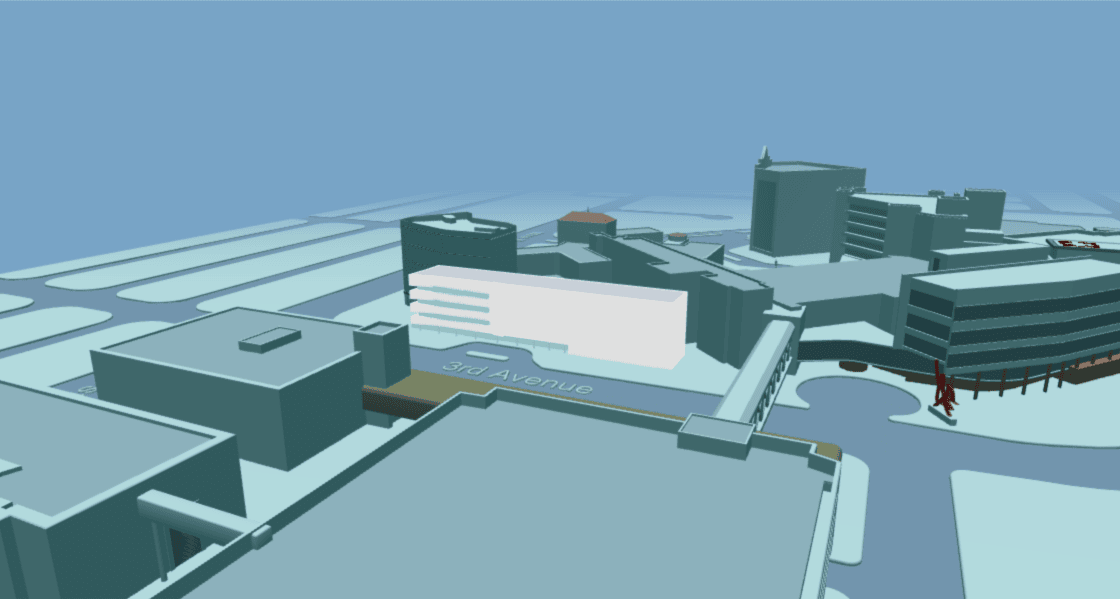
Find a Researcher

Ping Wang, PhD, is an associate professor in the Neuroimaging Innovation Center in the Department of Translational Neuroscience at Barrow Neurological Institute.
Dr. Wang’s expertise includes the development and application of novel magnetic resonance imaging (MRI) biomarkers for a more complete and accurate characterization of tissue composition and physical and chemical changes associated with pathology. He is a member of the International Society for Magnetic Resonance in Medicine and a senior member of the Institute of Electrical and Electronics Engineers.
Dr. Wang earned his master’s degree in electronic engineering from the North China Institute of Technology in Taiyuan Shanxi, China. He earned his doctorate in information and communication from the School of Electronic and Information Engineering at Xi’an Jiaotong University in Xi’an Shaanxi, China. He completed postdoctoral research fellowships in the Department of Radiation Oncology at Wake Forest University School of Medicine in Winston-Salem, North Carolina, and at Vanderbilt University Institute of Imaging Science in Nashville, Tennessee.
Dr. Wang’s current research focuses on the biophysical origins of MRI signals in vivo that give rise to useful image contrast. He has a particular interest in investigating the molecular and cellular basis of T1, T2, T1ρ, ADC, qMT, and CEST. He aims to use this understanding to develop better methods of imaging and to help interpret the imaging results in various neurological disorders, including neuromuscular and central nervous system diseases.
- Postdoctoral Research Fellowship, Vanderbilt University Institute of Imaging Science, Department of Radiology and Radiological Sciences, 2012-2016
- PhD, Xi’an Jiaotong University, Electronic and Information Engineering, 2002
- MS, North China Institute of Technology, Electronic Engineering, 1998
- BS, North China Institute of Technology, Test and Measurement Technology, 1995
- International Society for Magnetic Resonance in Medicine
- Institute of Electrical and Electronics Engineers
- Distinguished Reviewer, Journal of Magnetic Resonance Imaging, 2015-2019
- Elsevier Reviewer Recognition, 2019
- Educational Stipend Award Recipient, International Society for Magnetic Resonance in Medicine, 2006
- Excellent Graduate Student, Xi’an Jiaotong University, China, 2000
- Graduate Scholarship, Xi’an Jiaotong University, China, 2000
A 3D dual-echo spiral sequence for simultaneous dynamic susceptibility contrast and dynamic contrast-enhanced MRI with single bolus injection.
Date: 08/2024
Authors: Zhiqiang Li, Dinghui Wang, Melvyn B Ooi, Poonam Choudhary, Sudarshan Ragunathan, John P Karis, James G Pipe, C Chad Quarles, Ashley M. Stokes
Quantifying cerebral blood flow changes using arterial spin labeling: A comparative study of idiopathic rapid eye movement sleep behavior disorder and Parkinson's disease.
Date: 06/2024
Authors: Yuqi Zhi, Mingshen Chen, Chunshan Zhou, Yongxu Yang, Yan Huang, Xiaoyun Liang, Ping Wang, Xiaoyu Cheng, Chengjie Mao, Zhen Jiang, Yakang Dai, Bo Peng, Jiangtao Zhu
Outcomes associated to the time to treatment with intravenous tenecteplase for acute ischaemic stroke: subgroup analysis of the TRACE-2 randomised controlled clinical trial
Date: 01/2024
Authors: Shuya Li, Runqi Wangqin, Yuesong Pan, Aoming Jin, Hao Li, Lee H. Schwamm, Marc Fisher, Bruce C. Campbell, Mark W. Parsons, Ziran Wang, Hongguo Dai, Deyang Li, Runhui Li, Junhai Wang, David Wang, D Z. Wang, Yilong Wang, Xingquan Zhao, Zixiao Li, Huaguang Zheng, Yunyun Xiong, Xia Meng, Yongjun Wang
Chinese Stroke Association guidelines for clinical management of ischaemic cerebrovascular diseases: executive summary and 2023 update
Date: 12/2023
Authors: Liping Liu, Zixiao Li, Hongyu Zhou, Wanying Duan, Xiaochuan Huo, Weihai Xu, Shujuan Li, Ximing Nie, Huihui Liu, Jinjie Liu, Dapeng Sun, Yufei Wei, Guitao Zhang, Weizhuang Yuan, Lina Zheng, Jingyi Liu, David Wang, D Z. Wang, Zhongrong Miao, Yongjun Wang
When treating acute ischaemic stroke of LVO type, time window prevails over tissue window
Date: 12/2023
Authors: Xiaochuan Huo, Aoming Jin, Zhongrong Miao, Yongjun Wang, David Wang, D Z. Wang


Ping Wang, PhD, is an associate professor in the Neuroimaging Innovation Center in the Department of Translational Neuroscience at Barrow Neurological Institute.
Dr. Wang’s expertise includes the development and application of novel magnetic resonance imaging (MRI) biomarkers for a more complete and accurate characterization of tissue composition and physical and chemical changes associated with pathology. He is a member of the International Society for Magnetic Resonance in Medicine and a senior member of the Institute of Electrical and Electronics Engineers.
Dr. Wang earned his master’s degree in electronic engineering from the North China Institute of Technology in Taiyuan Shanxi, China. He earned his doctorate in information and communication from the School of Electronic and Information Engineering at Xi’an Jiaotong University in Xi’an Shaanxi, China. He completed postdoctoral research fellowships in the Department of Radiation Oncology at Wake Forest University School of Medicine in Winston-Salem, North Carolina, and at Vanderbilt University Institute of Imaging Science in Nashville, Tennessee.
Dr. Wang’s current research focuses on the biophysical origins of MRI signals in vivo that give rise to useful image contrast. He has a particular interest in investigating the molecular and cellular basis of T1, T2, T1ρ, ADC, qMT, and CEST. He aims to use this understanding to develop better methods of imaging and to help interpret the imaging results in various neurological disorders, including neuromuscular and central nervous system diseases.

- Postdoctoral Research Fellowship, Vanderbilt University Institute of Imaging Science, Department of Radiology and Radiological Sciences, 2012-2016
- PhD, Xi’an Jiaotong University, Electronic and Information Engineering, 2002
- MS, North China Institute of Technology, Electronic Engineering, 1998
- BS, North China Institute of Technology, Test and Measurement Technology, 1995
- International Society for Magnetic Resonance in Medicine
- Institute of Electrical and Electronics Engineers
- Distinguished Reviewer, Journal of Magnetic Resonance Imaging, 2015-2019
- Elsevier Reviewer Recognition, 2019
- Educational Stipend Award Recipient, International Society for Magnetic Resonance in Medicine, 2006
- Excellent Graduate Student, Xi’an Jiaotong University, China, 2000
- Graduate Scholarship, Xi’an Jiaotong University, China, 2000
A 3D dual-echo spiral sequence for simultaneous dynamic susceptibility contrast and dynamic contrast-enhanced MRI with single bolus injection.
Date: 08/2024
Authors: Zhiqiang Li, Dinghui Wang, Melvyn B Ooi, Poonam Choudhary, Sudarshan Ragunathan, John P Karis, James G Pipe, C Chad Quarles, Ashley M. Stokes
Quantifying cerebral blood flow changes using arterial spin labeling: A comparative study of idiopathic rapid eye movement sleep behavior disorder and Parkinson's disease.
Date: 06/2024
Authors: Yuqi Zhi, Mingshen Chen, Chunshan Zhou, Yongxu Yang, Yan Huang, Xiaoyun Liang, Ping Wang, Xiaoyu Cheng, Chengjie Mao, Zhen Jiang, Yakang Dai, Bo Peng, Jiangtao Zhu
Outcomes associated to the time to treatment with intravenous tenecteplase for acute ischaemic stroke: subgroup analysis of the TRACE-2 randomised controlled clinical trial
Date: 01/2024
Authors: Shuya Li, Runqi Wangqin, Yuesong Pan, Aoming Jin, Hao Li, Lee H. Schwamm, Marc Fisher, Bruce C. Campbell, Mark W. Parsons, Ziran Wang, Hongguo Dai, Deyang Li, Runhui Li, Junhai Wang, David Wang, D Z. Wang, Yilong Wang, Xingquan Zhao, Zixiao Li, Huaguang Zheng, Yunyun Xiong, Xia Meng, Yongjun Wang
Chinese Stroke Association guidelines for clinical management of ischaemic cerebrovascular diseases: executive summary and 2023 update
Date: 12/2023
Authors: Liping Liu, Zixiao Li, Hongyu Zhou, Wanying Duan, Xiaochuan Huo, Weihai Xu, Shujuan Li, Ximing Nie, Huihui Liu, Jinjie Liu, Dapeng Sun, Yufei Wei, Guitao Zhang, Weizhuang Yuan, Lina Zheng, Jingyi Liu, David Wang, D Z. Wang, Zhongrong Miao, Yongjun Wang
When treating acute ischaemic stroke of LVO type, time window prevails over tissue window
Date: 12/2023
Authors: Xiaochuan Huo, Aoming Jin, Zhongrong Miao, Yongjun Wang, David Wang, D Z. Wang
